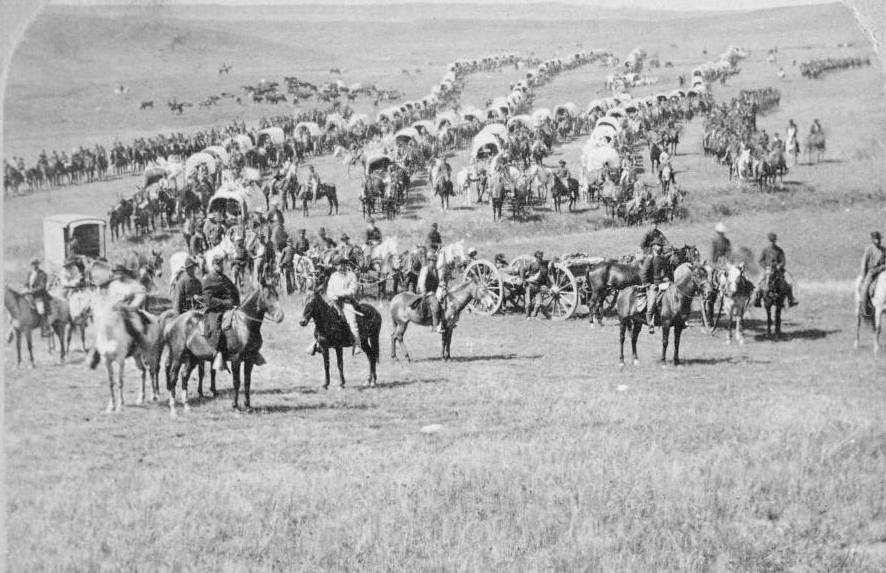
SOUTH DAKOTA
Reconstruction Vignette
This 1874 photo shows U.S. artillery, cavalry, and wagons traversing present-day South Dakota. They were invading Sioux territory in order to capitalize on the discovery of gold in the Black Hills. Federal officials promptly broke the 1868 Treaty of Fort Laramie, which had exclusively designated this area for Sioux settlement as part of the Great Sioux Reservation. Both the original treaty and reneging indicated the rapid destruction of Indigenous sovereignty at the hands of increasingly powerful Republicans and industrialists. During Reconstruction, they used broad discussions of U.S. reconciliation, citizenship, and racial inclusion to justify settler colonial initiatives and claims over capital. The Black Hills expedition searched for gold and prepared to enforce U.S. mining settlements, catalyzing the Great Sioux War between local Indigenous groups and U.S. invaders. In 1877, the federal government seized the Black Hills and, decades later, carved Mount Rushmore into them.
Source: DocsTeach
South Dakota
Standards Overview
Coverage of Reconstruction: Partial
ZEP Standards Rubric Score: 2 out of 10
The coverage of Reconstruction in South Dakota’s standards is partial, and their content is subpar. The South Dakota Department of Education adopted the current social studies standards in 2015. In 2020, social studies educators in the Department of Education created a set of documents to supplement the standards to provide further guidance for teachers called the “Social Studies Unpacked Documents.” One of the “notable changes” from the 2007 to 2015 standards was the inclusion of “standards for U.S. History in grades 9–12 that cover from the Revolution to Reconstruction.”
A new social studies standards revision committee began meeting in June 2021 with the goal of presenting recommendations for revisions that fall. However, the governor put the process on hold in October and announced that a new process with a new revision commission would proceed the following month. The state plans to hold public hearings for feedback to revisions in 2022 and fully implement the new standards in the fall of 2024.
Grade 8
The grade 8 social studies course spans the Revolution to Reconstruction.
The standards expect students to:
Investigate ways the Civil War changed the United States government.
Investigate how the abolition of slavery affected the life of African Americans in United States’ society.
Draw conclusions about the political, economic and social effects of Reconstruction in the United States.
Explain why and how the Bill of Rights and subsequent amendments were added to the Constitution.
Describe the economic effects of Reconstruction in the United States.
The “Unpacked Documents” provide some additional guidance on how students should:
Investigate the different ways how African Americans were denied fundamental rights and liberties during Reconstruction, along with making connections to how those events can still be affecting today’s society.
See how Reconstruction changes various components of the United States in all regions — not just the North and South.
Research the political, social, and economic changes of Reconstruction and how they affect the U.S. today (i.e., 13-15 Amendments, 10 percent plan, Amnesty Act, Wade-Davis Bill, Impeachment of Johnson, Compromise of 1877, segregation, Plessy vs. Ferguson/Brown vs. Board of Education, KKK, Transcontinental Railroad, Veterans, Sharecropping, Homestead Act.
High School
The high school U. S. history course spans the Civil War to World War II. The standards briefly mention Reconstruction.
The standards expect students to:
Analyze how individuals and groups reacted to social, political, and economic problems in the U.S. from Reconstruction through the Progressive Era.
Evaluate to what extent Reconstruction both succeeded and failed in its intentions
The “Unpacked Documents” do not provide any substantive additional guidance.
Educator Experiences
Notably, no educators or district leaders responded to our survey despite several concerted efforts to reach them. South Dakota is the only state in this report with no respondents and therefore the only state with no educator perspectives to highlight in this section.
Assessment
South Dakota’s standards on Reconstruction are quite vague. Some elements of the standards and the supplementary “Unpacked Documents” reflect modern scholarship and provide a good basis to build on for the ongoing revision of the standards. Their coverage of discrimination and disenfranchisement of Black people and of the positive and negative legacies of Reconstruction today are relatively robust.
The suggested learning objective for grade 8 students to “Investigate the different ways African Americans were denied fundamental rights and liberties during Reconstruction, along with making connections to how those events can still be affecting today’s society” is particularly strong. Missing is coverage of Black activism and advancement, the revolutionary possibilities of Reconstruction, and any mention of why and how white supremacy defeated Reconstruction..
Teaching Reconstruction effectively requires centering Black people’s struggles to redefine freedom and equality and gain control of their own land and labor during and after the Civil War. Any discussion of Reconstruction must also grapple with the role of white supremacist terrorism in the defeat of Reconstruction and the negative and positive legacies of the era that persist to this day.
In February 2021, Republican legislators withdrew HB1157, a bill designed to prohibit teachers from using materials that promote social justice. In May 2021, Gov. Kristi Noem signed the “1776 Pledge” to oppose teaching about systemic racism. In April 2022, Noem signed an executive order mandating that the department of education remove any “inherently divisive concepts” from its policies, materials, standards, and trainings. Several respondents to our survey expressed concern about the possible chilling effects on classroom education that such measures can have around the country, particularly on discussions of the history and legacies of Reconstruction.